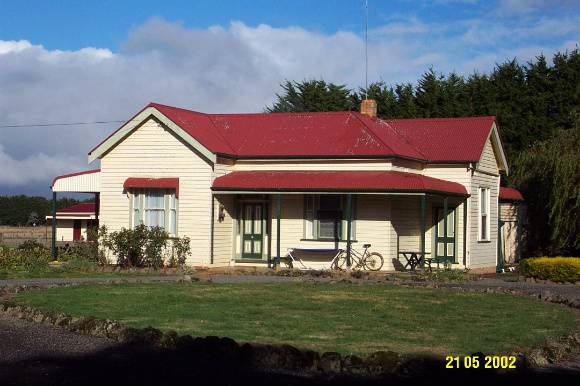| Back to search results » | Back to search page » |
|
BATESWORTH HOMESTEAD COMPLEX
LocationBatesworth Lane, PENSHURST VIC 3289 - Property No 14/32/
File Number730LevelStage 2 study complete |
|
Statement of Significance
What is significant?
The Batesworth homestead complex is located in Batesworth Lane about 3.5kms north of Penshurst off the Penshurst-Dunkeld Road. It comprises: the present post World War Two cream brick homestead set within an extensive garden, several adjacent outbuildings including a barn which is clad with corrugated iron recycled from the roofs of the Herrnhut buildings, the relocated timber parsonage from Tabor, a post World War Two off-form concrete woolshed since extended, and timber men's quarters. Charles Bates, who bought the land before 1870, established the property. The next owner was Joseph Tilley who sold Batesworth to Johann August Rentsch and Johanna Rentsch, nee Huf, third generation German Lutheran settlers. They built a modest and sober single-storey bluestone house with a detached bluestone kitchen, which was extended to accommodate their family of five children. Their son, Albert Edgar Rentsch moved the former 1909 Tabor parsonage to the site in 1951 and a barn incorporates recycled early corrugated iron from the abandoned Herrnhut buildings. Also after the Second World War, a new concrete woolshed was built which can be compared with the woolshed at nearby Torbank. The 1880s house was demolished and replaced with a conventional cream brick house. Men's quarters survive from the late nineteenth century and remnants of an extensive garden. Edwin and Elsie Rentsch who had managed the property retired to Portland in 1867 and the son of Albert Rentsch now manages the farm. The complex survives in excellent condition and with a high degree of integrity to its mid-twentieth century situation.
How is it significant?
The Batesworth homestead complex is of historical and architectural significance to the communities of Penshurst and Tabor and to the southern Grampians Shire.
Why is it significant?
The Batesworth homestead complex is of historical significance for its direct connections with three generations of the important Rentsch family and its branches, and particularly with Johann August Rentsch, his children Albert, Edwin and Elsie Rentsch, and his grandson John Albert, and their wives and children. Specifically, it demonstrates the steady success of the third, fourth and fifth generations of German Lutheran migrants in the area to the south and east of Hamilton in the face of great personal difficulties. The complex is of architectural significance as a group of buildings and in particular for the reconstruction of the Tabor parsonage, the recycling of Herrnhut materials and the concrete woolshed. The mature garden setting of the homestead enhances the overall significance.
Group
Farming and Grazing
Category
Homestead Complex







